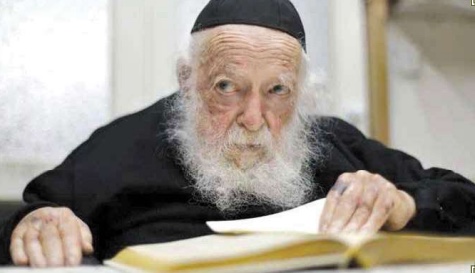This article originally appeared in the Jewish Home
K’lal Yisrael is in a deep state of mourning for the Sar HaTorah, HaGaon HaRav Chaim Kaninevsky Zt”l. HaRav Binyomin Forst Shlit”a remarked that we are no longer living in the same world. Before there was a world with Rav Chaim, and now we are in a world without him. It was a catastrophic loss, a veritable sea change.
Rav Chaim lived and breathed Torah. From a young age, Rav Chaim accepted upon himself a rigorous study schedule. He referred to this learning as chovos, literally debts. If missed these chovos needed to be paid. Rav Chaim became engaged to Rav Elyashiv’s daughter.
Rav Chaim was once overheard murmuring about his “chovos”. Alarmed, a mechutan worried that he was full of debts! Someone explained that “chovos” referred to his learning, not actual debt!
Rav Chaim kept this regular study schedule every year, making a siyum on the entire Torah on Erev Pesach. Many people have a relaxed learning schedule during Bein Hazmanim, not Rav Chaim. He constantly plowed through his rigorous learning schedule every day, finishing the entire Bavli and Yerushalmi once a year. He remarked that the seventh day of Pesach marked the beginning of an extra intensive week of “chovos”. His demanding schedule was fashioned after Talmud Bavli. While the Bavli has no gemara in Seder Zeraim other than Berachos, the Yerushalmi does. It seems that Rav Chaim learned through the entire seder of Mishnayos Zeraim in one week (besides for Berachos). This is an impressive but understandable feat. Yet he had to simultaneously finish ten entire tractates of Talmud Yerushalmi in the same week! Rav Chaim had his yearly learning schedule so organized, that in a Jewish leap year he was able to dedicate his additional time to authoring seforim and answering letters.
Rav Chaim was famous for responding to letters to the many letters he received. Very often, he responded with short, possibly one-word answers that were quick and to the point. One time, Rav Chaim received a letter and seemed to be contemplating it. His relative who was in the room was wondering what was so complex about this particular letter. Finally, Rav Chaim handed over the letter to his relative and asked him to read it. The letter was written in big bold letters. It stated “Lkavod Rav Kanievsky Shalom, We learned in Cheder in Parshas Mikeitz, that Pharaoh had a dream and seven cows came out of the river, and seven cows came out “Achareihen”-after them. I asked my Rebbe why does the word Achareihen end with a Nun and not a Mem, and he didn’t have an answer. Therefore I am asking the Rav.” It was signed “Moishy Cohen, second grade, Talmud Torah Tashbar.” After the relative finished reading the letter, Rav Chaim remarked “I could send a letter explaining the rules of grammar but the child wouldn’t understand.” (Perhaps also he didn’t want to insult the Rebbe that he didn’t know about male and female constructs) The relative said, “Then don’t respond to the letter.” Whereupon Rav Chaim remarked, “The reason I respond to letters is to give people chizuk, I never know if they actually get chizuk from my response. But this young boy will certainly receive chizuk if he gets a letter from me.” After a few moments, Rav Chaim chuckled and penned a response to the boy. “Paroh lived in Egypt and didn’t know Hebrew”!
Rav Chaim had a sense of humor as one could tell from his responses to various questions. Perhaps he picked this up from his uncle, the Chazon Ish. One time he asked his uncle “Are you a tzaddik?” His uncle responded “I’m a tzaddik Sofis! (referring to the final form of the letter)” Rav Chaim persisted and asked the Chazon Ish “Are you one of the 36 Tzaddikim?” His uncle answered, “I’m number 37!”.
The Kanievsky family was understandably very close to the Chazon Ish. Rav Chaim was once asked “Why did the Chazon Ish emigrate to Eretz Yisrael? He was living in a Torah metropolis, in Vilna!” Rav Chaim stated that he didn’t understand the question. Living in Eretz Yisrael fulfills a Torah mitzvah! Rav Chaim added that in truth there was an additional reason as well. HaGaon Rebbe Chaim Ozer Grodzinski advised the Chazon Ish to emigrate to Eretz Yisrael because perhaps there he would merit having children. Rav Chaim added that this idea is not new, it is found in Rashi in Yevamos (64a).
One ruling of the Chazon Ish, made life easier for the Kanievsky family. One time, the Chazon Ish found out that the Steipler, Rav Chaim’s father, stayed up all night searching for chametz. The Chazon Ish issued two directives to make the bedikah shorter. 1. When searching for Chametz on the floor, one only needs to search for chometz the size of a kezayis. 2. Perform a sale of chometz on the 13th, and then one doesn’t need to check the places that were sold. Even with these rulings the search for Chometz in the Kanievsky apartment always took many hours. Rav Chaim emptied out many drawers to properly check them. Whereupon, he told his grandon “Please put everything back into the drawers. The mitzvah of bedikas chometz is only derabbanan. Causing distress to your grandmother is a Torah violation.” Indeed, when Rav Chaim was younger he would return all the items himself to their proper place.
Rav Chaim expressed surprise that people in America have such large houses. “How do they ever fulfill the mitzvah of bedikas chometz?” This was Rav Chaim’s way of always viewing everything through a torah prism. Indeed someone once asked Rav Chaim in the middle of the year about which apartment to purchase. Rav Chaim said to purchase the smaller one because it will make the bedikah easier. Rav Chaim adopted the practice of visiting his grandchildren’s homes soon after they were married. On one occasion he noticed that a grandchild had a long hallway. He commented, “The bedika here will take a long time.”
Rav Chaim’s dedication to his family was legendary. When he took his young child to cheder for the first time, he went with all the other fathers to acclimate their sons to the new cheder. After all the fathers had left, the Rebbe noticed that Rav Chaim was still sitting in the back learning Torah. The Rebbe remarked to Rav Chaim, that of course he is welcome to stay as long as he wants but all the other fathers left already. Rav Chaim said, “But if I leave my child will cry!” The Rebbe responded “Yes. It’s true. However, I have found that the children only cry a little bit. I give them a candy and then everything is fine.” But Rav Chaim persisted “I don’t want my child to cry a little bit!” The Rebbe said “Fine. Of course you could stay but what will happen tomorrow?” Rav Chaim said “I’ll come back tomorrow. All the other parents aren’t able to learn or perform their jobs here. I could learn the same here as I learn in Kollel.” Rav Chaim indeed came back the next day, and the next day, and the next day. Rav Chaim attended preschool class with his young son for 30 days until his son was fully acclimated and would not cry upon his departure.
One day Rav Chaim took his children on a Chol HaMoed outing. Classically, he took them to the zoo. However, a visit to the zoo with Rav Chaim is different. When he saw the first animal, he told his children all the places where this animal is mentioned in Tanach and in the gemora. He also explained what halachos are relevant to it. He then went to the next animal and proceeded to do the same. Some other patrons of the zoo overheard these encyclopedic Torah remarks and decided to follow Rav Chaim. Stil others noticed the group and came closer to see what was happening. Pretty soon, Rav Chaim had a huge crowd of people following him as he served as a spiritual tour guide at the zoo!”
That again was another example of Rav Chaim perceiving everything through a prism of Torah. One day Rav Chaim received a letter and the writer mentioned that he lived on Rechov Rimon, “pomegranate street.” Rav Chaim repeated this fact a few times. Someone present asked him, “Why is this fact notable?” Rav Chaim answered that when the Beis Hamikdosh will be built speedily in our days, we will need pomegranate wood to roast our korbon pesach. The gemora states that the custom was to use specifically pomegranate wood for this purpose. Perhaps pomegranates grow on that street.
One time a fundraiser mentioned to Rav Chaim that a wealthy American donor asked for a beracha for his older single daughter so that she may find her bashert. Rav Chaim gave the daughter a hearty blessing. Whereupon, the fundraiser mentioned to Rav Chaim that he has an older son that also needs a shidduch. Rav Chaim said, “The solution to your problem is found in the gemora!” The gemora in Bava Kama says that when someone prays for someone else and he needs the same result, he will be answered as well. Rav Chaim said “You should daven for the donor, and ask him to daven for you!” (Rav Chaim reasoned that this ploy works even if one is just davening for his friend so that he should be answered. The proof is from a Mogen Avraham (OC 230:6) that deals with saying the equivalent of ‘gezunteit’) Within a year, the fundraiser shared the good news with Rav Chaim that the donor’s daughter is getting married soon. However, the fundraiser mentioned that his son unfortunately still had not found a shidduch. Rav Chaim replied, “Don’t worry, your son will surely find a shidduch before the wedding!” The wedding was set to take place on Thursday of the following week. That Thursday afternoon, the fundraiser held a vort for his son. (Courtship in their community is much quicker than it is in non-chassidiche America)
A businessman came to Rav Chaim with a question. He typically wears a hat and jacket for bentching. However, most of his business meetings take place at a restaurant while sharing a meal. He is embarrassed to put on a hat and jacket for bentching at the conclusion of the meeting and meal. The others at the meeting may think it’s strange. The businessman asked, “Is it really necessary for me to continue my custom?” Rav Chaim responded that he certainly should. The Mishna Berura says that wearing a hat and jacket is proper attire for bentching. Moreover, wearing a hat and jacket for bentching is a segula for wealth. Soon after, the businessman was discussing a real estate deal over a restaurant meal. The meeting was successful in that they had come to terms on most of the issues. However, the sticking point was a fifteen million shekel price difference between the two sides. The businessman reasoned that it may be a sizable sum, but perhaps in the context of the entire deal, it may be worth it to give in. He decided that he would come to a decision after bentching. He got up to get his hat and jacket. The other party called after him “Fine. I agree to your price.” After he returned to the table and bentched, he asked the other party “Why did you suddenly give in?” The other party said “I saw you suddenly stand up and get your hat. Since you were about to walk away from the deal, I quickly decided that even at your price, it was still a good deal!”
It may be hard for us to fully comprehend Rav Chaim’s appreciation of Torah and his non-appreciation of wealth. There is an established custom that the Baal Korei receives the aliyah for the tochacha-the section of the Torah that describes the punishments for those that don’t follow the Torah. The reasoning is that it is a bad omen to randomly call someone up specifically to get that aliyah. The baal korei is already standing there and doesn’t need to be called up. Moreover, it is not a bad omen for him since the baal korei always gets that aliyah.
Someone learning in kollel commented “I’m not into such things. I have no problem getting that aliyah.” Sure enough, the kollel man asked the gabbai for that aliyah. Soon after, a distant relative of the kollel man passed away in the United States. The kollel man traveled there to claim his inheritance. The inheritance involved a profitable company. Soon, the kollel man became very wealthy and spent his time tending his business. When this was related to Rav Chaim, his response was “You see that he shouldn’t have taken the aliyah!
There are certain mitzvos that the gemora says will cause a person to have a bountiful parnassah. One such example is netilas yadayim. Similarly, the gemora says reciting Havadala over wine is a segulah to have boys. Indeed, Rav Chaim would advise couples who were childless to recite Havdala specifically over wine, and not to use grape juice. Yet, Rav Chaim said that we see there are people who are careful about netilas yadayim and do not have a bountiful parnassah. Likewise, there are people who recite havdala on wine and did not merit children. Rav Chaim said that there are two explanations for this. One is offered by the Mishna Berura (158:38). A person may have sins that prevent the blessing from being fulfilled. (See there for which sin the Chofetz Chaim said prevents children.) The second is that not having children and sustenance can be a source of atonement. Yet if a person doesn’t deserve children or sustenance, their lack is not a source of atonement, since he didn’t deserve it anyway. Once a person does a mitzvah that should merit him to have children or parnossah, now what he lacks turns into a source of atonement. (Rav Chaim explained that the two answers are really intertwined.)
There was once a man waiting in the cue to see Rav Chaim. He stood out from all the others because of his long hair. Through the hair, his earrings were barely visible. On the top of his mound of hair there was a symbolic kippah. When it was his turn to speak to Rav Chaim, he stated that he and his wife were childless. They went to see a fertilifty specialist. At one point the doctor said that there was nothing more he could do for the couple. They asked if there was any other doctor they should visit. The doctor replied, “At this point, I can only recommend speaking to Rav Chaim Kanievsky in Bnei Brak.” Rav Chaim listened to his story and said “But a woman can’t have children with another woman! Take a haircut” The man’s face lit up and said “Right away! Sure. I’ll do anything!” Rav Chaim replied “But it’s sefiras haomer now. One doesn’t take a haircut during this time.” The man waited until Lag B’Omer to take a haircut and merited having a child.
Incredibly, there are times that Rav Elyashiv zt”l was asked for a Bracha and he sent the petitioners to his son-in-law!
Yet, for his part, Rav Chaim refused to take any credit for his blessings. He said that when misfortune and pain were destined to end, they would end on their own as the Gemora states in Avoda Zara.
It was surprising how short the hespedim for Rav Chaim were. But then one contemplates, how can one eulogize the gadol hador? The same is with this article. This article is by no means comprehensive, rather it offers a few glimpses of a gadol.

















